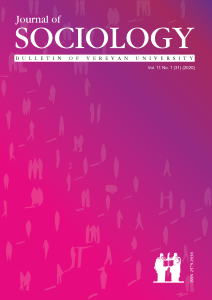Principal Features of Family Social Capital in Russian Regions
The Case of Vologda Region
DOI:
https://doi.org/10.46991/BYSU:F/2020.11.1.073Keywords:
Selected:Family, family social capital, resources for investing, Coleman J., Bourdieu P.Abstract
The article is devoted to the study of family social capital. On the basis of a theoretical model, based on the conceptual developments of J. Coleman and P. Bourdieu, an analysis of empirical data obtained in the course of a sociological study conducted in the Vologda Oblast was carried out. It was found that most of the families have the resources to form their social capital and invest in it. However, it is distributed extremely unevenly. A narrow radius of trust does not promote the growth of social capital. Its deficiency can further restrict its transmission to the next generations.
References
Liausheva, S.A. (2010) The influence of society modernization on the institution of the family, Bulletin of the Adygea State University. Series 1: Regional studies: philosophy, history, sociology, jurisprudence, political science, cultural science, No. 2, pp. 105-110.
Hanifan, L.I. (1967) The Rural School. Community Center, Annals of the American Academy of Political and Social Science, pp. 130–138. Doi: https://doi.org/10.1177/000271621606700118
Coleman, J. (2001) Capital social and human, ONS, No. 3, pp. 120-139.
Coleman, J.S. (1988) The Creation and Destruction of Social Capital: Implications for the Law, 3 Notre Dame J.L. Ethics & Pub. Policy, No 3, pp. 375 - 404.
Bourdieu, P. (2002) Forms of capital, Economic Sociology, No. 5. pp. 60-75. Doi: https://doi.org/10.17323/1726-3247-2002-5-60-74
Afanasyev, D.V., Guzhavina, T.A. & Mehova, A.A. (2016) Social capital in the region: on the issue of measuring and building an indicator model, Economic and social changes: facts, trends, forecast, No. 6, pp. 110-125. Doi: https://doi.org/10.15838/esc.2016.6.48.6
Guzhavina, T.A. & Vorobyeva, I.N. (2017) The use of factor analysis in measuring social capital, Social space, No 4 (11), retrieved from: http://sa.vscc.ac.ru/article/2377
Granovetter, M. (2009) Strength of weak ties, Economic Sociology, T. 10. No. 4, Pp. 31-50. Doi: https://doi.org/10.17323/1726-3247-2009-4-31-50
Coleman, J. (2001) Capital social and human, ONS, No. 3, pp. 120-139.
Putnam, R. (1995) Bowling Alone: America’s Declining Social Capital,Journal of Democracy, pp. 65-78. Doi: https://doi.org/10.1353/jod.1995.0002
Sandefur, G., Meier, A. & Hernandez, P. (1999) Families, Social Capital, and Educational Continuation, CDE Working Paper No. 99-19, Center for Demography and Ecology. Madison, WI: University of Wisconsin-Madison.
Coleman, J. (2001) Capital social and human, ONS, No. 3, pp. 120-139
Shimko, S. V., Ozerov A. A. & Tarasenko L.V. (2012) Socialization risks: theoretical and methodological problems of research, Bulletin Adyghe State University. Series 1: Regional Studies: Philosophy, History, Sociology, Jurisprudence, Political Science, Cultural Studies, No 2, pp. 128-134
Aeby, G., Widmer, E.D. & Carlo, I.D. (2014) Bonding and Bridging Social Capital in Step- and First-Time Families and the Issue of Family Boundaries, Interpersona, Vol. 8(1), pp. 51–69. Doi: https://doi.org/10.5964/ijpr.v8i1.149
Downloads
Published
How to Cite
Issue
Section
License
Copyright (c) 2020 Tatiana Guzhavina

This work is licensed under a Creative Commons Attribution-NonCommercial 4.0 International License.








